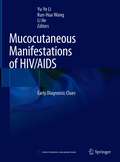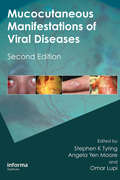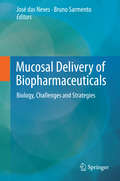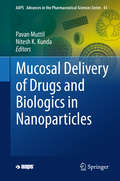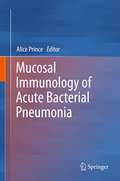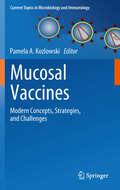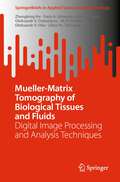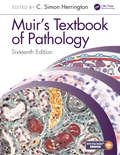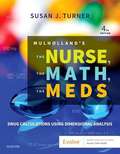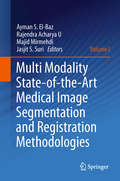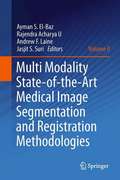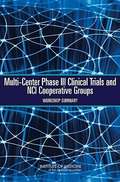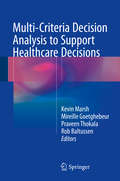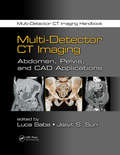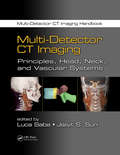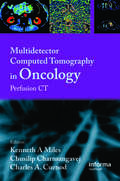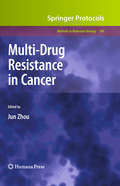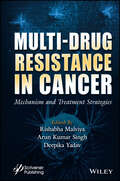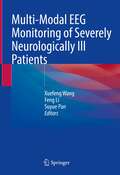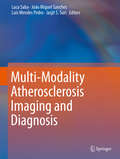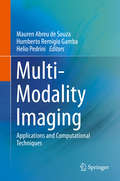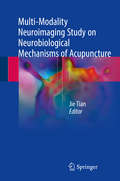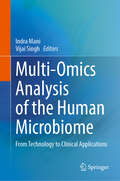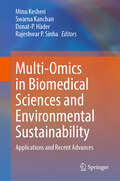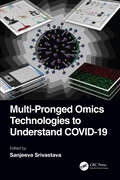- Table View
- List View
Mucocutaneous Manifestations of HIV/AIDS: Early Diagnostic Clues
by Li He Yu-Ye Li Kun-Hua WangThis book introduces a number of HIV/AIDS cases with mucocutaneous lesions. HIV/AIDS can manifest a variety of skin lesions due to immunological disorder, opportunistic infections and tumors always occur primarily with skin lesions. The cases included in this book reflect the diseases spectrum and evolution of mucocutaneous lesions at different stages before and after AIDS antiretroviral therapy (ART) as well. This book consists of nine chapters, including fungal, viral, bacterial, parasitic, neoplastic, inflammatory diseases, syphilis and ART-induced diseases, etc. More than 300 cases and 600 photos of representative and important clinical significances are selected, showing the different clinical characteristics of the same disease under different immune status. Clinical photos are combined with clear and concise medical history along with the discussion on it, by which the readers can understand why skin lesions can be used as the early diagnostic clues to HIV/AIDS infection. Moreover, every chapter summarizes the similarity and characteristics of each type of skin diseases, which outlines and explains why they are AIDS-related mucocutaneous lesions.
Mucocutaneous Manifestations of Viral Diseases: An Illustrated Guide to Diagnosis and Management
by Omar Lupi Angela Yen Moore Stephen K TyringExpertly distinguish viral diseases from other infectious or noninfectious diseases and choose the most effective treatment with this definitive Second Edition.The only existing text to address issues of skin manifestations of viral disease, Mucocutaneous Manifestations of Viral Diseases explores the diagnosis, treatment, and pathogenesis of viral
Mucosal Delivery of Biopharmaceuticals
by Bruno Sarmento José Das NevesBiopharmaceutical medicines, the newest class of therapeutics, are quite heterogeneous and include a range of molecules such as proteins, peptides, vaccines and nucleic acids, with use in virtually all therapeutic fields (e. g. cancer and infectious diseases, vaccination, metabolic dysfunctions) and diagnostics. This edited book gives a concise and up-to-date overview of the biological features justifying the use of different human mucosa as delivery routes for biopharmaceuticals, the technological strategies that have been followed so far regarding the optimization of mucosal potentialities as well as the challenges that arise with the advent of new biopharmaceutical drugs and alternative means of administration. Following a brief introduction, the first section addresses general aspects of the biology of mucosal tissues and their unique aspects toward beneficial or deleterious interaction with biopharmaceuticals and their delivery systems. The second part reviews the different delivery strategies that have recently been investigated for different mucosal sites. The third section describes the development and clinical applications of drug delivery systems and products enclosing biopharmaceuticals for mucosal delivery, with a focus on the most successful case studies of recent years. The last section briefly centers on relevant aspects of the regulatory, toxicological and market issues of mucosal delivery of biopharmaceuticals. Scientists and researchers in the fields of drug delivery, material science, biomedical science and bioengineering as well as professionals, regulators and policy makers in the pharmaceutical, biotechnology and healthcare industries will find in this book an important compendium of fundamental concepts and practical tools for their daily research and activities.
Mucosal Delivery of Drugs and Biologics in Nanoparticles (AAPS Advances in the Pharmaceutical Sciences Series #41)
by Pavan Muttil Nitesh K. KundaNanotechnology has revolutionized the approach to designing and developing novel drug delivery systems. The last two decades have seen a great interest in the use of nanotechnology to offer efficient ways of delivering new and existing drugs and macromolecules. The focus of this book is the application of nanotechnology to deliver drugs and biological agents by the mucosal routes of administration i.e. nasal, pulmonary, buccal, and oral routes. It provides an overview of nanotechnology in drug delivery with a description of different types of nanoparticles, methods of preparation and characterization, and functionalization for site-specific drug delivery. The emphasis is on the use of nanoparticles in treating various cancers and infectious diseases. It broadens the use of nanoparticles by including biologics, including vaccines and immunotherapies, apart from drugs and acknowledges the concerns around the potential toxicity of nanoparticles to the host; several chapters will discuss the biodistribution of these nanoparticles when mucosal routes of administration are employed. Further, the interaction of nanoparticles with the host’s immune cells is discussed. Moreover, it reviews the regulatory aspects of nanotechnology in product development, especially when delivered by the mucosal route of administration. Lastly, discusses the challenges and opportunities to manufacture nanoparticles on an industrial scale. This book is the first of its kind to focus on the design, development and delivery of nanoparticles when administered by different mucosal routes.
Mucosal Immunology of Acute Bacterial Pneumonia
by Alice PrinceIn contrast to the substantial literature that focuses upon innate immune signaling in the gut, there is remarkably less known about the response of the airway to bacterial pathogens. The purpose of this book will be to review the current status of theunderstanding of the pathogenesis of acute bacterial pneumonia, slanted toward the mucosal immunology of these infections. It will describe, in general, the signaling cascades that control the proinflammatory response to bacterial infection in the lung. How innate immune signaling is orchestrated in response to specific common airway pathogens is addressed, targeting Staphylococus aureus (including MRSA), Streptococcus pneumoniae and Klebsiella pneumoniae. By describing the general immunological responses to conserved bacterial components and then detailing how specific organisms cause infection, this book provides a targeted but comprehensive review of this important topic.
Mucosal Vaccines
by Pamela A. KozlowskiThis volume is focused on the development of vaccines which generate immune effectors capable of blocking mucosal entry or peripheral pathogen spread. A critical first step in the design of mucosal vaccines is the selection of administration route. Not all mucosal immunization routes are created equally when it comes to eliciting immune responses in multiple body compartments. This subject and situations when a mucosal route may not be required for vaccine delivery are reviewed here with an emphasis on the sublingual immunization route, which may offer a safer alternative to the nasal route for induction of broadly disseminated immune responses. External host defenses that inhibit entry of microorganisms at mucosal surfaces also pose obstacles to the efficient internalization of mucosally-applied vaccines. Transcutaneous immunization with appropriate adjuvants and permeation enhancers can induce mucosal immune responses and may be advantageous for bypassing these luminal barriers. Other chapters describe strategies for enhancing uptake of mucosal vaccines, for instance through targeted delivery to antigen-sampling M cells, construction of virus-like particles which mimic natural pathogens, addition of mucoadhesives or formulation as nanoparticles. Topics include edible vaccines as well as plant-based production of subunit or particulate vaccines that could be administered by any route. Dry powder vaccines that could be insufflated or directly applied to mucosal surfaces may be particularly ideal for mass vaccination in developing countries. The manufacture, stability and efficacy of powder formulations is comprehensively reviewed. We conclude with chapters on two of the greatest challenges facing mucosal vaccine development: human immunodeficiency virus and bioterrorist agents. This monograph highlights progress and information that should prove invaluable for the development of contemporary vaccines that prevent infection by these and other mucosal pathogens.
Mueller-Matrix Tomography of Biological Tissues and Fluids: Digital Image Processing and Analysis Techniques (SpringerBriefs in Applied Sciences and Technology)
by Zhengbing Hu Iryna V. Soltys Yuriy A. Ushenko Oleksandr V. Dubolazov M. P. Gorsky Oleksandr V. Olar Liliya Yu. TrifonyukThis book presents experimental investigations and digital image processing, highlighting the interaction of polarized radiation with phase-inhomogeneous and optically anisotropic biological layers. The promising and efficient use of vector-parametric description of the formation of polarization-inhomogeneous object fields is noted. Applications of a set of Mueller-matrix polarimetry methods are highlighted. The book includes- structural and logical scheme of multi-parameter (singular, interference and layer-by-layer Stokes-polarimetric), polarization-correlation study of the structure of distributions of the number of singularities, maps of local contrast of interference distributions and layer-by-layer maps of microscopic polarization azimuth and ellipticity; determination of relationships between changes in the magnitude of statistical parameters characterizing polarization-correlation distributions and pathology of prostate tumors.
Muir's Textbook of Pathology: Sixteenth Edition
by C. Simon HerringtonThis classic text sets a standard in this subject by outlining the scientific aspects that underlie pathological processes, relating these to specific organ systems and placing all in a context that the student of medicine or pathology can appreciate, understand and enjoy. The clearly defined and easy-to-follow structure, enhanced by numerous photographs and explanatory line diagrams, focuses on core material without neglecting novel concepts and up-to-the minute detail. A one-stop-shop in pathology, it reflects fully the integration of pathology into clinical teaching whether system or problem-based, and will take the student right through medical school and beyond to postgraduate training.
Mulholland's The Nurse, The Math, The Meds: Drug Calculations Using Dimensional Analysis
by Susan TurnerMulholland’s The Nurse, The Math, The Meds, 4th Edition helps you overcome any math anxiety you may have by clearly explaining how to use dimensional analysis to minimize drug calculation errors. It shows how to analyze and set up problems, estimate a reasonable answer, and then evaluate the answer for accuracy. But first, a review of basic math ensures that you remember essential math skills. Updated by nursing educator Susan Turner, this edition includes plenty of practice exercises to help you understand and master each aspect of dimensional analysis.
Multi Modality State-of-the-Art Medical Image Segmentation and Registration Methodologies. Volume 1
by Jasjit S. Suri Majid Mirmehdi Ayman S. El-Baz Rajendra Acharya UWith the advances in image guided surgery for cancer treatment, the role of image segmentation and registration has become very critical. The central engine of any image guided surgery product is its ability to quantify the organ or segment the organ whether it is a magnetic resonance imaging (MRI) and computed tomography (CT), X-ray, PET, SPECT, Ultrasound, and Molecular imaging modality. Sophisticated segmentation algorithms can help the physicians delineate better the anatomical structures present in the input images, enhance the accuracy of medical diagnosis and facilitate the best treatment planning system designs. The focus of this book in towards the state of the art techniques in the area of image segmentation and registration.
Multi Modality State-of-the-Art Medical Image Segmentation and Registration Methodologies: Volume II
by Jasjit S. Suri Ayman S. El-Baz Rajendra Acharya U Andrew F. LaineWith the advances in image guided surgery for cancer treatment, the role of image segmentation and registration has become very critical. The central engine of any image guided surgery product is its ability to quantify the organ or segment the organ whether it is a magnetic resonance imaging (MRI) and computed tomography (CT), X-ray, PET, SPECT, Ultrasound, and Molecular imaging modality. Sophisticated segmentation algorithms can help the physicians delineate better the anatomical structures present in the input images, enhance the accuracy of medical diagnosis and facilitate the best treatment planning system designs. The focus of this book in towards the state of the art techniques in the area of image segmentation and registration.
Multi-Center Phase III Clinical Trials and NCI Cooperative Groups: WORKSHOP SUMMARY
by Institute of Medicine of the National AcademiesThe NCI-sponsored cooperative groups have made important contributions to improving treatment for many types of cancer, including breast, ovarian, colorectal, and childhood cancers. Cooperative group research has been instrumental in establishing innovative treatments that improve outcomes and quality of life. Despite these successes, the Cooperative Group Program has faced a number of challenges that threaten its effectiveness. To address this problem, the National Cancer Policy Forum (NCPF) convened a workshop titled "Multi-Center Phase III Clinical Trials and NCI Cooperative Groups" in Washington, DC, on July 1-2, 2008. The purpose of the workshop was to outline the challenges that the public clinical cancer research enterprise faces, and to identify possible solutions to these challenges.
Multi-Criteria Decision Analysis to Support Healthcare Decisions
by Kevin Marsh Mireille Goetghebeur Praveen Thokala Rob BaltussenRepresenting the first collection on the topic, this book builds from foundations to case studies, to future prospects, providing the reader with a rich and comprehensive understanding of the use of multi-criteria decision analysis (MCDA) in healthcare. The first section of the collection presents the foundations of MCDA as it is applied to healthcare decisions, providing guidance on the ethical and theoretical underpinnings of MCDA and how to select MCDA methods appropriate to different decision settings. Section two comprises a collection of case studies spanning the decision continuum, including portfolio development, benefit–risk assessment, health technology assessment, priority setting, resource optimisation, clinical practice and shared decision making. Section three explores future directions in the application of MCDA to healthcare and identifies opportunities for further research to support these.
Multi-Detector CT Imaging: Abdomen, Pelvis, and CAD Applications
by Martin GardnerDevelopments in CT technology during the last 20 years have impressively improved its diagnostic potentialities. Part of a two-volume set that covers all aspects of CT imaging, Multi-Detector CT Imaging: Abdomen, Pelvis, and CAD Applications contains easily searchable clinical specialty chapters that provide specific information without need of an
Multi-Detector CT Imaging: Principles, Head, Neck, and Vascular Systems
by Jasjit S. Suri Luca SabaDevelopments in CT technology during the last 20 years have impressively improved its diagnostic potentialities. Part of a two-volume set that covers all aspects of CT imaging, Multi-Detector CT Imaging: Principles, Head, Neck, and Vascular Systems contains easily searchable clinical specialty chapters that provide specific information without need
Multi-Detector Computed Tomography in Oncology: CT Perfusion Imaging
by Kenneth A Miles Charles-André CuenodThis new text-atlas focuses on anatomy and procedural strategy for perfusion CT imaging in the diagnosis and management of cancer. It will use a combination of pictures and schematic diagrams that show how this new modality can be used to assess anatomy and guide therapeutic interventions. It begins with an introductory section discussing the state
Multi-Drug Resistance in Cancer
by Jun ZhouWith the devastating complication of cancer cells becoming simultaneously resistant to many structurally and mechanistically unrelated drugs, the efficacy of chemotherapeutic management of cancer often becomes severely limited. In Multi-Drug Resistance in Cancer, leading researchers in the field provide comprehensive and up-to-date reviews of multidrug resistance mechanisms, from over-expression of ATP-binding cassette drug transporters such as P-glycoprotein, multidrug resistance-associated proteins, and breast cancer resistance protein, to the drug ratio-dependent antagonism and the paradigm of cancer stem cells. The extensive volume also includes strategies to overcome multidrug resistance, from the development of compounds that inhibit drug transporter function to the modulation of transporter expression, as well as techniques for detection and imaging of drug transporters, methods for investigation of drug resistance in animal models, and strategies to evaluate the efficacy of resistance reversal agents. As a volume in the highly successful Methods in Molecular BiologyTM series, this work provides the kind of detailed description and implementation advice that is crucial for getting optimal results. Authoritative and cutting-edge, Multi-Drug Resistance in Cancer offers a state-of-art collection of reviews and methods for both basic and clinician investigators who are interested in the vital study of cancer multi-drug resistance mechanisms and reversal strategies.
Multi-Drug Resistance in Cancer: Mechanism and Treatment Strategies
by Arun Kumar Singh Rishabha Malviya Deepika YadavMULTI-DRUG RESISTANCE IN CANCER The book details the mechanisms underlying multi-drug cellular resistance and the targets of novel chemotherapeutic agents. Cancer is a major killer all over the world. Even with all the progress made, chemotherapy is still the mainstay of modern cancer treatment. The progression of the cellular defeat of numerous independent anticancer drugs in terms of their chemical structure is a major barrier to successful chemotherapy. Multi-drug resistance (MDR) is a term for the fact that most cancer patients exhibit this phenomenon. According to the numbers, drug resistance carries the blame for 90% of cancer patient deaths. Refractory cancer and tumor recurrence are common outcomes of prolonged chemotherapy. Because of the prevalence of drug-resistance mutations, the difficulty of treating tumors increases and the therapeutic efficacy of drugs decreases. Multi-Drug Resistance in Cancer: Mechanism and Treatment Strategies contains nine chapters that cover topics such as: studying the mechanics of resistance to drugs by autophagy; studies to delineate the role of efflux transporters; expression of drug transporters; resistance to targeted therapies in breast cancer; advances in metallodrug driven combination treatment for cancer; and use of natural agents for the overcoming of cancer drug resistance. The book aims to provide the latest data on the mechanisms of cellular resistance to anticancer agents currently used in clinical treatment. It provides a better understanding of the mechanisms of MDR and targets of novel chemotherapy agents which should guide future research concerning new effective strategies in cancer treatment. Audience This book is written for pharmaceutical and biomedical scientists and researchers at both the bench and in the clinic who are interested in the mechanisms and strategies for overcoming cancer’s multi-drug resistance.
Multi-Modal EEG Monitoring of Severely Neurologically Ill Patients
by Feng Li Xuefeng Wang Suyue PanThis book provides practical information on applications of multi-modal EEG monitoring in patients with severely neurologically diseases. The First part systematically introduces the modern EEG techniques, and multi-modal EEG monitoring system for severe neurological illness. In the second part, identification of EEG artifacts and interpretation of common abnormal EEG patterns is presented. Accompanying more than 50 typical cases and 200 EEG records, the following chapters discusses EEG’s changes and clinical significance in coma, ischemic-hypoxic encephalopathy, status epilepsy, Creutzfeldt-Jakob disease, traumatic brain injury, and other diseases in details. In addition, application of multi-modal EEG in monitoring intracranial pressure and predicting suicide risk is also included. It will be a valuable reference for professionals in neurology, neurosurgery, emergency care, psychiatry, technology specialists of EEG and senior nurses with basic EEG monitoring knowledge.
Multi-Modality Atherosclerosis Imaging and Diagnosis
by Jasjit S. Suri João Miguel Sanches Luca Saba Luís Mendes PedroStroke is one of the leading causes of death in the world, resulting mostly from the sudden ruptures of atherosclerosis carotid plaques. Understanding why and how plaque develops and ruptures requires a multi-disciplinary approach such as radiology, biomedical engineering, medical physics, software engineering, hardware engineering, pathological and histological imaging. Multi-Modality Atherosclerosis Imaging, Diagnosis and Treatment presents a new dimension of understanding Atherosclerosis in 2D and 3D. This book presents work on plaque stress analysis in order to provide a general framework of computational modeling with atherosclerosis plaques. New algorithms based on 3D and 4D Ultrasound are presented to assess the atherosclerotic disease as well as very recent advances in plaque multimodality image fusion analysis. The goal of Multi-Modality Atherosclerosis Imaging, Diagnosis and Treatment is to fuse information obtained from different 3D medical image modalities, such as 3D US, CT and MRI, providing the medical doctor with some sort of augmented reality information about the atherosclerotic plaque in order to improve the accuracy of the diagnosis. Analysis of the plaque dynamics along the cardiac cycle is also a valuable indicator for plaque instability assessment and therefore for risk stratification. 4D Ultrasound, a sequence of 3D reconstructions of the region of interest along the time, can be used for this dynamic analysis. Multimodality Image Fusion is a very appealing approach because it puts together the best characteristics of each modality, such as, the high temporal resolution of US and the high spatial resolutions of MRI and CT.
Multi-Modality Imaging: Applications and Computational Techniques
by Mauren Abreu de Souza Humberto Remigio Gamba Helio PedriniThis book presents different approaches on multi-modality imaging with a focus on biomedical applications. Medical imaging can be divided into two categories: functional (related to physiological body measurements) and anatomical (structural) imaging modalities.In particular, this book covers imaging combinations coming from the usual popular modalities (such as the anatomical modalities, e.g. X-ray, CT and MRI), and it also includes some promising and new imaging modalities that are still being developed and improved (such as infrared thermography (IRT) and photoplethysmography imaging (PPGI)), implying potential approaches for innovative biomedical applications.Moreover, this book includes a variety of tools on computer vision, imaging processing, and computer graphics, which led to the generation and visualization of 3D models, making the most recent advances in this area possible. This is an ideal book for students and biomedical engineering researchers covering the biomedical imaging field.
Multi-Modality Neuroimaging Study on Neurobiological Mechanisms of Acupuncture
by Jie TianThis book introduces essential advances in acupuncture studies using multi-modality neuroimaging, which provides insights into how specific brain networks are involved in acupuncture effects in humans. Stimulating different acupoints to treat various clinical conditions is usually accompanied by multi-dimensional physiological as well as psychological responses, which are regulated by the central nervous system. The book addresses disease-specific neural correlates and acupuncture-targeted regulatory encoding in the brain, and explains the temporal-spatial encoding in brain networks to clarify the acupuncture mechanisms. By highlighting the targeting mechanisms of typical indications of acupuncture, this book provides a scientific explanation for acupuncture therapy.
Multi-Omics Analysis of the Human Microbiome: From Technology to Clinical Applications
by Vijai Singh Indra ManiThis book introduces the rapidly evolving field of multi-omics in understanding the human microbiome. The book focuses on the technology used to generate multi-omics data, including advances in next-generation sequencing and other high-throughput methods. It also covers the application of artificial intelligence and machine learning algorithms to the analysis of multi-omics data, providing readers with an overview of the powerful computational tools that are driving innovation in this field. The chapter also explores the various bioinformatics databases and tools available for the analysis of multi-omics data. The book also delves into the application of multi-omics technology to the study of microbial diversity, including metagenomics, metatranscriptomics, and metaproteomics. The book also explores the use of these techniques to identify and characterize microbial communities in different environments, from the gut and oral microbiome to the skin microbiome and beyond. Towards theend, it focuses on the use of multi-omics in the study of microbial consortia, including mycology and the viral microbiome. The book also explores the potential of multi-omics to identify genes of biotechnological importance, providing readers with an understanding of the role that this technology could play in advancing biotech research. Finally, the book concludes with a discussion of the clinical applications of multi-omics technology, including its potential to identify disease biomarkers and develop personalized medicine approaches. Overall, this book provides readers with a comprehensive overview of this exciting field, highlighting the potential for multi-omics to transform our understanding of the microbial world.
Multi-Omics in Biomedical Sciences and Environmental Sustainability: Applications and Recent Advances
by Rajeshwar P. Sinha Donat-P. Häder Minu Kesheri Swarna KanchanThis book offers a comprehensive exploration of the cutting-edge multi-omics technologies that are revolutionizing research across biomedical sciences and environmental sustainability. It addresses the urgent need for interdisciplinary research by integrating multi-omics approaches with bioinformatics and artificial intelligence. The book explores evolution of traditional omics technologies into comprehensive multi-omics strategies that synergize data output through advanced computational tools. It covers diverse topics such as health and disease mechanisms, drug discovery innovations, COVID-19 responses, cancer treatment personalization, neuroscience insights into brain disorders, cyanobacterial natural compounds' potential for biofuel production, lichen symbiosis studies, and more. This volume integrates genomics, proteomics, metabolomics, and more with bioinformatics, machine learning, and artificial intelligence to address complex challenges in health and the environment. With contributions from renowned scholars worldwide, this book illuminates recent advances through illustrative figures and case studies that enhance understanding of complex pathways while bioinformatics strategies streamline research outcomes. This book is a must-read for researchers, academics, and professionals in life sciences, biomedical fields, and environmental studies, interested in advancing their knowledge of multi-omics applications. It is also beneficial for scientists involved in drug design or biotechnological innovations related to environmental sustainability.
Multi-Pronged Omics Technologies to Understand COVID-19
by Sanjeeva Srivastava"COVID-19 and Omics Technologies" is a comprehensive, integrative assessment of recent information and knowledge collected on SARS-CoV-2 and COVID-19 during the pandemic based on omics technologies. It demonstrates how omics technologies could better investigate the infectious disease and propose solutions to the current concerns. The value of multi-omics technologies in understanding disease etiology and host response, discovering infection biomarkers and illness prediction, identifying vaccine candidates, discovering therapeutic targets, and tracing pathogen evolution is discussed in this book. These factors combine to make it a valuable resource to enhance understanding of both "Omics technology" and "COVID-19" as a disease. The book covers the most recent understanding of COVID-19 and the applications of cutting-edge studies, making it accessible to a large multidisciplinary readership. The book explains how high-throughput technologies and systems biology might assist to solve the pandemic’s challenges and deconstruct and appreciate the substantial contributions that omics technologies have made in predicting the path of this unforeseeable pandemic. Features: In-depth summary of clinical presentation, epidemiological impact, and long-term sequelae of COVID-19 pandemic. A systematic overview of omics-based approaches to the study of COVID-19 biology. Recent research results and some pointers to future advancements in methodologies used. Detailed examples from recent studies on COVID-19 encompassing different omics methodologies. A detailed description of methodologies and notes on the applications of state-of-the-art technologies. This book is intended for scientists who need to understand the biology of COVID-19 from the perspective of omics investigations, as well as researchers who want to employ omics-based technologies in disease biology.
